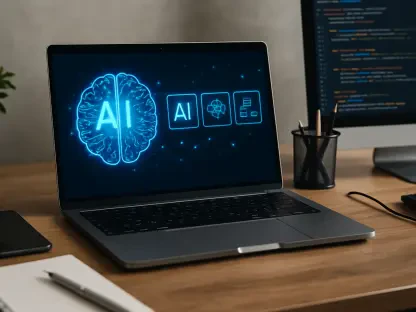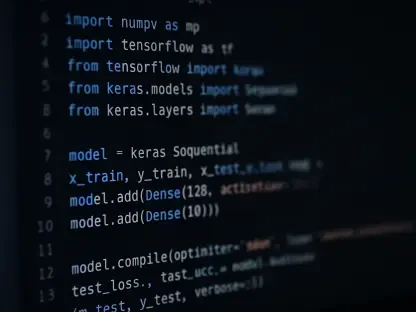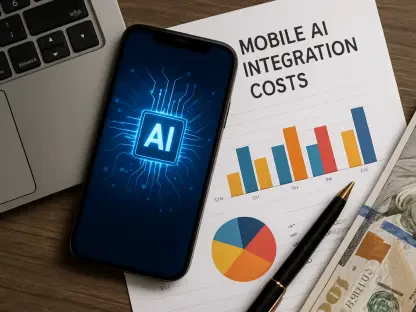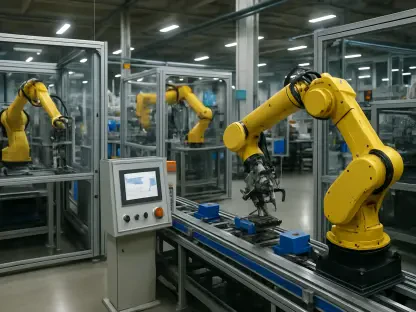The Current Landscape of Software Development and AI Integration
The software development industry stands at a pivotal moment, with Artificial Intelligence (AI) reshaping the very foundation of how code is written, tested, and deployed, while technology drives nearly every sector from finance to healthcare. The demand for faster, more efficient development cycles has never been higher, propelling AI from a peripheral curiosity to a central pillar in modern toolchains, as developers increasingly rely on intelligent systems to streamline complex tasks. This integration of AI is not just a trend but a fundamental shift, promising to redefine productivity and innovation in the field.
Recent studies underscore the scale of this transformation. Reports from industry leaders like GitHub and Microsoft reveal that developers using AI tools such as Copilot can achieve up to 55% faster coding speeds. This statistic highlights a broader movement where AI is becoming indispensable, with a majority of professionals adopting these technologies to enhance their workflows. Beyond mere speed, AI offers the potential to tackle repetitive tasks, allowing teams to focus on creative problem-solving and strategic initiatives.
What sets this era apart is the transition of AI from a novelty to an integral component of development ecosystems. No longer confined to isolated use cases, AI is embedding itself across entire pipelines, influencing everything from planning to deployment. This systemic adoption signals a new paradigm where leveraging intelligent tools is not just an advantage but a necessity for staying competitive in a rapidly evolving landscape.
Key Trends and Market Insights in AI-Driven Development
Emerging Trends Shaping AI Adoption
A significant trend in software development is the shift from standalone AI tools to their deep integration across all stages of the development pipeline. This holistic approach ensures that AI influences not just coding but also planning, testing, and monitoring, creating a seamless workflow. Generative AI, in particular, is automating between 20% and 45% of software engineering tasks, according to McKinsey, fundamentally altering traditional processes with its capacity to generate code, scripts, and documentation on demand.
Beyond automation, developer expectations are evolving to demand more comprehensive AI applications. Code completion, while valuable, is no longer sufficient; professionals seek tools that assist with architecture design, debugging, and even operational support. This push for broader utility reflects a maturing understanding of AI’s potential to act as a collaborative partner rather than a mere assistant, driving efficiency at every touchpoint.
The impact of these trends is evident in how workflows are being restructured. Teams are increasingly relying on AI to anticipate issues before they arise, such as identifying vulnerabilities during early design phases or suggesting optimizations during deployment. This proactive capability marks a departure from reactive problem-solving, positioning AI as a cornerstone of modern software engineering strategies.
Market Growth and Future Projections
Adoption rates for AI tools in software development are climbing steadily, with measurable impacts on key performance indicators. Metrics such as those outlined in the DORA framework—lead time for changes, deployment frequency, and mean time to restore—show marked improvements when AI is integrated effectively. These gains are not merely anecdotal but backed by data demonstrating enhanced productivity and reduced error rates across diverse projects.
Looking ahead, forecasts suggest that AI will continue to redefine the industry by prioritizing scalability and operational efficiency. From this year onward to 2027, market analysts predict a surge in AI-driven platforms that streamline development cycles while maintaining high standards of quality. This growth trajectory indicates that organizations investing in AI now will likely gain a significant edge over competitors slower to adapt.
The long-term vision for AI in software development points to an ecosystem where intelligent systems handle routine tasks autonomously, freeing human talent for innovation. Such a future hinges on the ability to integrate AI at scale, ensuring that tools not only accelerate processes but also align with broader business goals. This alignment will be critical for sustaining growth in an increasingly digital economy.
Challenges in Implementing AI in Software Development
Implementing AI within software development is not without hurdles, particularly when it comes to security and compliance. Risks such as prompt injection and unintended data exposure pose significant threats, especially in environments handling sensitive information. These vulnerabilities necessitate robust safeguards to prevent breaches that could undermine trust and operational integrity.
Technological barriers also complicate AI adoption, with inconsistent infrastructure often hindering seamless integration. Many organizations struggle with legacy systems that are ill-equipped to support advanced AI tools, leading to friction in workflows. Additionally, the lack of standardized governance for AI-generated code creates uncertainty, as teams grapple with ensuring quality and accountability in automated outputs.
Addressing these challenges requires innovative solutions tailored to the unique demands of software development. Standardized platforms can help bridge infrastructure gaps, while automated guardrails offer real-time oversight to mitigate risks. By establishing clear protocols and leveraging tools designed for security and compliance, organizations can navigate these obstacles and unlock AI’s full potential without compromising safety or efficiency.
Regulatory and Compliance Considerations for AI Use
The regulatory landscape for AI in software development is becoming increasingly complex, with frameworks like the NIST Secure Software Development Framework and the OWASP Top 10 for Large Language Models setting critical guidelines. These standards aim to address vulnerabilities inherent in AI systems, ensuring that tools are used responsibly across industries. Compliance is not optional but a foundational requirement for maintaining trust and avoiding legal repercussions.
Embedding compliance into development workflows is essential for meeting these regulatory demands. Tools like Open Policy Agent (OPA) and policy-as-code mechanisms enable real-time adherence to rules, guiding developers without disrupting their autonomy. This proactive approach contrasts with traditional after-the-fact audits, offering a more efficient path to regulatory alignment.
Real-world examples illustrate how compliance can be balanced with innovation. Allianz Global Investors, for instance, employs policy engines that provide soft warnings rather than hard stops, allowing developers to make informed decisions while staying within guidelines. Automated checks further streamline this process, ensuring that adherence to standards becomes a natural part of the development cycle rather than a burden.
Future Directions for AI in Software Development
The trajectory of AI in software development points to groundbreaking innovations that could redefine operational norms. Emerging areas such as AI-driven incident response and automated architecture documentation promise to enhance resilience and clarity in complex projects. These advancements suggest a future where AI not only accelerates tasks but also anticipates and resolves challenges before they escalate.
Potential disruptors, including next-generation generative AI models and internal developer portals like Backstage, are poised to further transform the landscape. These tools aim to simplify workflows by providing standardized environments and reusable templates, reducing manual effort. Their adoption could accelerate the shift toward fully integrated, AI-supported ecosystems over the coming years.
Influencing factors such as cultural shifts toward AI literacy and global technology trends will also shape this evolution. Continuous upskilling remains vital, as teams must adapt to rapid advancements and maintain a competitive edge. Embracing these changes will require a commitment to learning and collaboration, ensuring that AI’s benefits are realized across diverse organizational contexts.
Five Strategic Methods to Maximize AI’s Impact
Method 1 – Codifying Compliance with AI and Guardrails
Embedding compliance directly into development processes through AI tools and guardrails ensures that regulatory standards are met in real time. Policy engines like Open Policy Agent enable continuous monitoring of configurations, guiding teams toward compliant practices without halting progress. This method shifts compliance from a reactive burden to a proactive advantage.
Hargreaves Lansdown provides a compelling example of this approach, using automated testing and code coverage targets to expedite releases while minimizing compliance exceptions. Such practices demonstrate how AI can enforce rules seamlessly, producing audit-ready evidence that satisfies stringent industry requirements. The result is a streamlined workflow that prioritizes both speed and security.
Method 2 – Extending AI Across the Software Lifecycle
Applying AI across every stage of the software lifecycle—from backlog refinement to incident response—maximizes its transformative potential. Rather than limiting AI to code generation, this method leverages it for test creation, documentation, and operational support, creating a comprehensive impact. The goal is to enhance efficiency at every phase of development.
Lloyds Banking Group exemplifies this strategy by modernizing pipelines to integrate AI throughout, resulting in improved DORA metrics and reduced rework. By empowering AI to suggest solutions while preserving human oversight, organizations can address issues proactively. This holistic application ensures that benefits are not siloed but felt across the entire development spectrum.
Method 3 – Creating an AI-Ready Platform with Golden Paths
Platform engineering plays a crucial role in reducing friction for AI adoption by establishing standardized “golden paths” for development tasks. These predefined workflows, supported by internal developer portals like Backstage, provide consistent environments where AI tools can operate effectively. The focus is on simplifying complex processes through uniformity.
Global Payments showcases the value of this approach, utilizing secure technology stacks to enable seamless AI orchestration. Hardened base images and optimized preview environments further enhance scalability, minimizing errors and manual intervention. Such infrastructure investments are essential for ensuring that AI delivers reliable, repeatable outcomes across projects.
Method 4 – Governing AI Code Generation with Care and Consistency
Robust governance is critical to managing the risks associated with AI-generated code, particularly in terms of security and compliance. Frameworks like the NIST AI Risk Management Framework offer structured guidance for addressing vulnerabilities such as prompt injection. Consistent oversight ensures that outputs align with organizational standards.
SEB’s model of developers acting as “conductors of agents” highlights the importance of human accountability, supported by automated rollback mechanisms for failed AI suggestions. Additional measures like license checks and dependency analysis within pipelines further safeguard quality. These practices collectively mitigate risks while preserving the speed advantages of AI.
Method 5 – Upskilling Teams to Transform Engineering Culture
Fostering AI literacy through targeted training and peer-led sessions is vital for sustainable adoption within organizations. By making proficiency with AI tools a core competency, teams can fully leverage their capabilities, much like established practices such as test-driven development. This cultural shift prioritizes continuous learning as a strategic asset.
Global Payments demonstrates the impact of this method, using developer experience surveys to measure progress in cultural transformation. Involving security and audit teams in AI adoption also creates a unified approach to risk management. Metrics beyond mere tool usage, such as defect rates, provide deeper insights into the effectiveness of these efforts.
Conclusion and Strategic Recommendations
Reflecting on the insights gathered, it becomes clear that AI has emerged as a powerful catalyst for change in software development when guided by strategic methods. The exploration of compliance integration, lifecycle expansion, platform readiness, governance, and cultural transformation reveals actionable pathways that organizations have successfully navigated to enhance productivity and innovation.
Looking ahead, the next steps involve prioritizing systemic integration over isolated tools, ensuring that AI is woven into every layer of the development process. Establishing robust governance frameworks has proven essential to balance speed with security, while continuous learning initiatives have laid the groundwork for long-term adaptability. Organizations are encouraged to invest in scalable platforms and collaborative training, positioning AI as a cornerstone of competitive advantage in an ever-evolving technological landscape.









